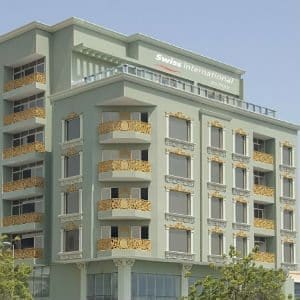If you check into a hotel over the holidays, there is a good chance it will be undergoing renovation. Here's why: typically, major hotel renovations occur every seven years. But the economic meltdown in 2008 — which shaved 15 percent off of occupancy rates in that one year for luxury hotels, as well as a significant drop in revenue per available room, according to the Wall Street Journal — disrupted that cycle.
Now, with the economy bouncing back, hotels are seizing the moment to finally improve their rooms, lobbies and dining experiences for guests. Furthermore, the months between November and January are the slower ones for non-resort hotels, and hospitality flags are rushing to start their refreshes this season and throughout 2014, which is on track to be one of the busiest stretches for hotel renovations in memory. Rising occupancy levels are one motivating factor for hotels to renovate. As Hotel News Now explains, hotels will see a 4.6 percent bump in average daily rate during 2014, as well as a 6 percent rise in revenue per available room.
This race to re-do is proving to be an exciting and challenging time for travelers and those who lodge them. Here's what both sides can expect.

Rendering by CBT Architects of The Hotel George, Washington, DC
For hoteliers: With so many renovations taking place across the country, quality furniture is in high demand. Finding the right pieces in large quantities within a tight timeframe is a huge challenge for hoteliers. Since many suppliers downsized when the recession hit, demand for pieces is spread out among fewer of them, a problem exacerbated by this surge in demand. But there are some ways to get the job done well, on time and on budget. These include getting your furniture counts right, the first time. This may seem like a simple suggestion, but avoiding mistakes when determining how much furniture will be needed in a redesign or renovation is critical. A designer may be great with aesthetics, but the books and the execution of a renovation are essential for meeting timelines.
Also, sourcing domestically may prove crucial to success. While Thailand or China are often the default markets from which to purchase, sourcing domestically will ensure that items won't get stuck in customs en route and shipping costs should be significantly lower. Furthermore, domestic shipping will give you peace of mind when adhering to a tight deadline. Facing these challenges will require a good working relationship between the hotel, contractor, and supplier to ensure a shorter renovation period and allow hotels to improve their revenue available per room more quickly.

Rendering by CBT Architects of The Hotel George, Washington, DC
For travelers: While renovations can be an inconvenience due to the noise and closed off spaces, the results will yield some new and interesting design trends. These include lobby transformations that turn dead space into lively settings and dramatic room and corridor renovations hotel-wide. Examples include the Sofitels in Chicago and Washington, D.C. (which will begin a complete overhaul later next year), and the renovation now underway at the Seaport Hotel lobby in Boston, that will reposition Aura and Tamo restaurants by the Spring.
While some hotels such as the Hotel Sax Chicago and the Helix in Washington will rework all spaces and rooms by the end of next year, most renovations will occur just in the rooms, corridors and suites. The Hotel George, a Kimpton boutique in Washington, D.C., is transforming its 139 rooms. And the Donovan, also in D.C., is renovating 193 rooms. Both the George and Donovan hotels are expected to be completed by February.
Another big trend is the creation of more flexible environments for meals (that also produce more income for the hotel) much like the Gaby Bar in New York. Recently, CBT designed a full 6,178-square-foot renovation for the Palm Terrace restaurant at the PGA National Resort and Spa in Palm Beach Gardens, FL. The renovated 170-seat space includes three flexible, private dining rooms which are divided by unique drapery. In the morning, the area is the perfect location for the breakfast power meeting serving a full hot breakfast buffet. By night, the venue serves as a poolside location for special events and the unique drapery that created the private dining rooms reveals the extensive space available for large gatherings. Inspired by the desert palm, this indoor/outdoor venue located by the pool features organic wood floors and crisp light colors that juxtapose with the soft greens of abstracted palm leaves in bold and dramatic graphics that adorn the walls.
Finally, from a design perspective, colors will remain muted with tones of greys, blues and browns.
Color comes from the style and location of the hotel. For example, at Hotel Chicago we're using Benjamin Moore colors, including Wickham Grey, Iced Mauve, Flint Black Satin, Super Nova and Van Deusen blue to evoke the sense of urbanity, iconic architecture and the elemental colors that reflect Chicago.
Of course, renovations are fodder for bragging rights and marketing campaigns. It follows that the upcoming renovation cycle is especially important, with so many hotels fighting for the same customers who are once again traveling and expecting the best in luxury service and accommodations.
About the author
Jacqueline McGee is a Principal at CBT Architects, where she leads the hospitality and high-end residential sector.
Source: Boston.com












